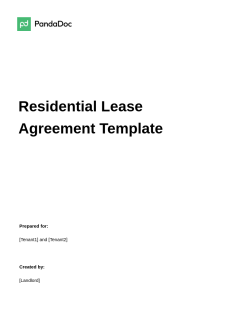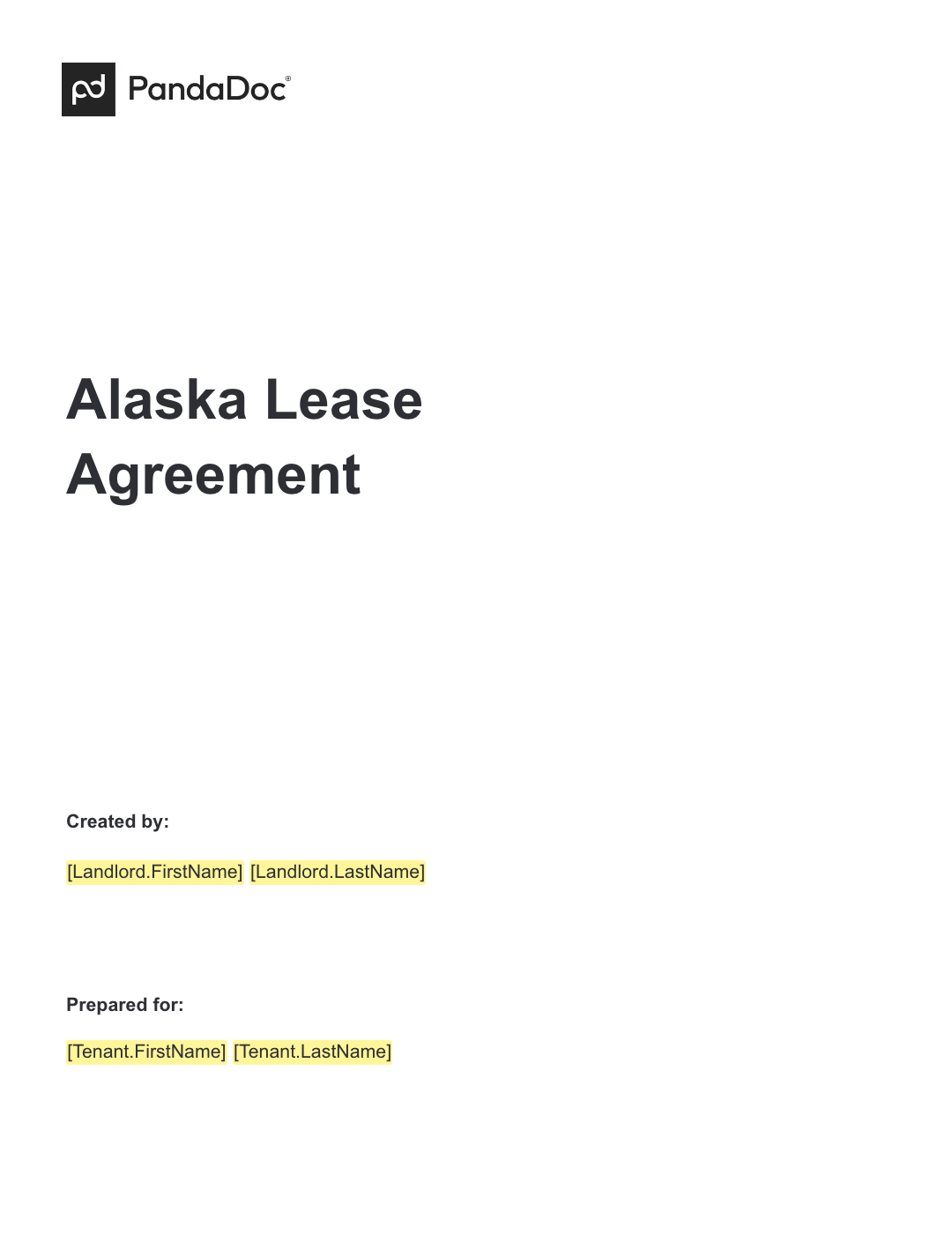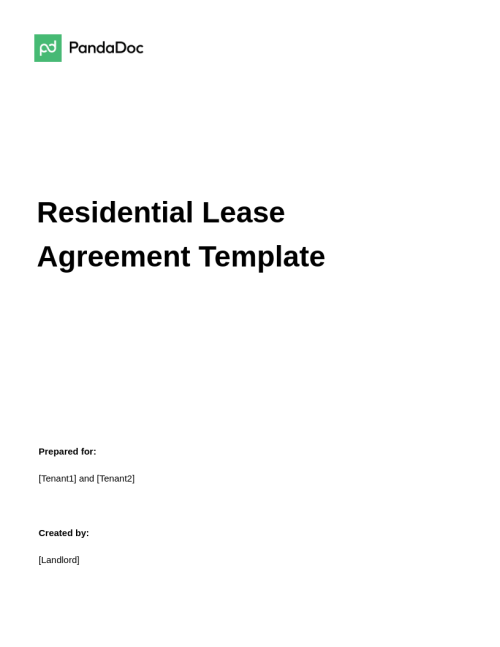Key Takeaways
- Alaska’s Uniform Residential Landlord and Tenant Act explains the regulations regarding leases.
- Lessors can ask for up to two (2) months’ rent as the security deposit. They have 14 days to return it to the lessee.
- The notice period for evictions depends primarily on the lessee’s type of violation.
- Lessors must provide at least 24 hours’ notice before entering the property.
- There are four mandatory disclosures in Alaska’s laws.
Alaska Lease Agreement Templates
Residential Lease Agreement

Residential Lease Agreement Template
Used 5,326 times
This Residential Lease Agreement Template is perfect and legal for a realtor or private homeowner looking to lease out their home.
Use this template when leasing a residential property in Alaska to establish the terms and conditions of the rental agreement between a landlord and a tenant.
Alaska Apartment Lease
Utilize this template when leasing an apartment specifically in Alaska, detailing the rental terms and obligations between a landlord and a tenant within an apartment complex.
Alaska Room Rental
Employ this template when renting out a single room within a residential property in Alaska, defining the terms and responsibilities agreed upon between the landlord and the tenant occupying the room.
Alaska Month-to-Month Lease
Use this template when establishing a month-to-month rental agreement for residential or commercial properties in Alaska.
Commercial Lease Agreement
Utilize this template when leasing a commercial property in Alaska, outlining the terms and conditions between a landlord and a tenant for business use.
Lease to Purchase Agreement
Use this template when entering into a lease agreement with an option to purchase a property specifically in Alaska, defining the terms for both the lease and potential purchase.
Sublease Agreement
Employ this template when subleasing a residential or commercial property in Alaska, detailing the agreement between the original tenant (sublessor) and the new tenant (sublessee), including responsibilities and terms.
Understanding Alaska Rental Laws
Alaska’s Uniform Residential Landlord and Tenant Act details the lessor-lessee relationship and laws. It explains what lessors should pay attention to under Title 34: Property, including:
| Laws | Name | Description |
| Article 9, Sections 34.03.320 to 34.03.380 | General Provisions | A section detailing the definitions and basic terms of lease agreements. |
| Article 2, Sections 34.03.020 to 34.03.030 | Rental Agreements; Effect of unsigned or undelivered rental agreement | Information about the processing of drawing up and signing a lease and what happens afterward. |
| Article 2, Section 34.03.040 | Prohibited provisions in rental agreements | Tenant rights and provisions that landlords can’t require of tenants. |
| Article 3, Section 34.03.100; Article 4, Section 34.03.120 | Landlord to maintain fit premises; Tenant Obligations | Explanation of the obligations from both the landlord and the tenant. |
| Article 3, Section 34.03.070 | Security deposits and prepaid rent | Laws surrounding security deposits and how much landlords can ask. |
| Article 7, Section 34.03.290 | Periodic tenancy and holdover | Details the notice period parties must provide when terminating the lease. |
| Article 6, Section 34.03.220 | Noncompliance with rental agreement; failure to pay rent | Eviction processes for different reasons. |
| Article 4, Section 34.03.140 | Access | An explanation of the landlord’s right of access and entry to the unit. |
| Article 6, Section 34.03.225. | Limitations on mobile home park operator’s right to terminate | The different rules that govern mobile homes. |
Security Deposit Limits
- For most rental units, the maximum security deposit possible is two (2) months’ rent. However, it doesn’t apply to rental units with a monthly rental amount of $2,000 or more.
- Lessors don’t need to pay any interest on the security deposit to the lessee.
- A pet security deposit cannot be more than one (1) month’s rent.
- Within 14 days of ending the agreement, the lessor must return the security deposit. If there are any deductions on it, they must also provide an itemized statement of deductions.
Eviction Procedures
- Lessors can only terminate a lease due to the following reasons:
- Failure to pay rent: Requires seven (7) days’ notice
- Lease violation: Requires 10 days’ notice
- Unconditional quit notice: Requires five (5) days’ notice
- Failure to pay utilities: A three (3) day notice to remedy the fault, with an additional two (2) days in which they must move out if they don’t remedy it.
- Unconditional quit notices are only eligible if the lessee repeats the same violation within six (6) months of previously receiving notice for the violation.
- Unconditional quit notices can also be 24 hours if the lessee purposely causes damages to the unit worth $400 or more. Another instance where it’s valid is if the lessee engages in or permits others to engage in prostitution on the premises.
Right to Enter (Landlord)
- Lessors have to provide at least 24 hours’ notice before entering the property. They can only enter at reasonable times and with the lessee’s consent.
- The lessee unreasonably withholding their consent is prohibited. Lessees can seek remedies if the lessor abuses their right of entry.
- Only in the case of a true emergency or unit abandonment can the lessor enter the property without notice.
- Alaska’s laws don’t state that the notice of entry has to be in writing.
Disclosures
Mandatory disclosures are critical, as the lease can become invalid without them. Alaska lease agreements has four disclosures that every lease agreement must contain:
- Security Deposit Deductions (Explain under which conditions lessors can make deductions)
- Information of the Property’s Authorized Agent (name and address)
- Name and Address of Owner (or the person acting on their behalf)
- Clause of Extended Absence (the lessee must inform the lessor if they plan to be away from the rental for more than seven (7) days.)



